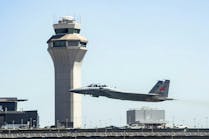Northrop Grumman’s New Airborne Navigation System Achieves Successful Flight Test
Northrop Grumman Corporation has conducted a successful flight test of its advanced airborne navigation solution, Embedded Global Positioning System (GPS) / Inertial Navigation System (INS) Modernization, known as EGI-M. It is the first time that EGI-M, equipped with an M-Code capable receiver, has been tested in flight.
- M-Code technology enables missions to be conducted in GPS-contested and GPS-denied environments.
- The M-Code capable GPS receiver is a core component of Northrop Grumman’s EGI-M program, engineered to quickly transmit positioning, navigation and timing information.
- The fully operational EGI-M system will feature a modular platform interface, designed to easily integrate with current platform navigation systems, supporting advanced software and hardware technology upgrades now and in the future.
Ryan Arrington, vice president, navigation and cockpit systems, Northrop Grumman, said, “This flight test is a major step forward in developing our next generation airborne navigation system. The EGI-M capability developed by Northrop Grumman enables our warfighters to navigate accurately and precisely through hostile and contested environments.”
Details on EGI-M:
Testing took place in May aboard a testbed aircraft. Flight test data confirmed that Northrop Grumman’s prototype EGI-M solution, the M-Code capable LN-351, performed at standards equal to its current LN-251 INS / GPS system, featuring modern fiber optic gyro technology.
Critical design review for EGI-M was completed in 2020. Launch platforms for Northrop Grumman’s EGI-M are the E-2D Advanced Hawkeye and the F-22 Raptor. Additional fixed-wing and rotary-wing platforms across Department of Defense and allied forces have selected Northrop Grumman’s EGI-M as their future navigation solution to support mission-critical systems.



